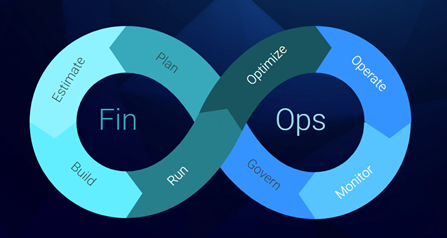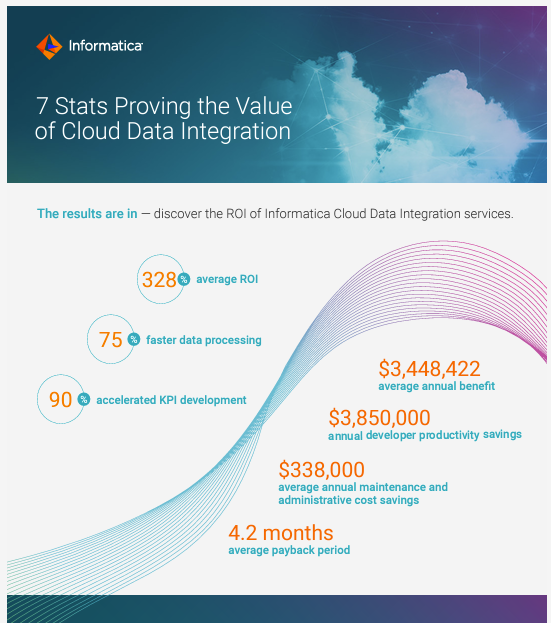How FinOps-Powered Cloud Data Integration Helps Reduce Data Processing Costs by 75%
Last Published: Jul 05, 2024 |

With its unlimited scalability and ease of use, a cloud-native platform is an invaluable resource for successful data management. However, moving to the cloud can also come with a cost. Costs that can quickly add up if you don’t take the time to optimize your data management platform. But by leveraging a combination of technology, sound business principles and advanced architectures, you can achieve significant ROI.
Challenges of Cloud Data Management
According to Flexera, more than half of organizations spend at least $2.4 million in the cloud each year1. And for some large companies, the bill can top $100 million per year.2 It’s easy to overspend on cloud services with no visibility or predictability of utilization.
And we can see how it happens: Setup is straightforward. And the availability of cloud resources gives you a fast way to address performance problems, without even taking cost implications into account. By not taking the time to optimize your data management platform, you can end up overspending and missing the mark on expected ROI. There’s a way around this, and it’s called cloud financial operations, or FinOps.
Drive ROI with FinOps
FinOps is a framework that provides visibility, control and governance within cloud operations to maximize the business value derived from cloud services. In fact, when used effectively, FinOps can help organizations reduce cloud costs by as much as 20% to 40% every month.3
FinOps covers the entire software lifecycle, from development to production. In addition to helping reduce costs, FinOps can help you achieve your desired business objectives by making data-driven decisions about the best way to utilize cloud resources.
Let’s review how implementing FinOps on your data pipelines can give you a competitive edge.

Benefits of Implementing FinOps on Your Data Pipeline
The premise behind FinOps is to reduce (or eliminate in some cases) unproductive costs to help run a more cost-conscious culture. Here are four benefits of using FinOps principles for managing your data pipelines.
- Cost estimation: FinOps encourages you to put a proactive budget management system in place before you create a data pipeline. This can help you access the cost each time you run a job. AI- and ML-enabled recommendation tools can help you with capacity planning, cost prediction and limit setting. You can start with the minimum amount of funds required to meet your service level agreement (SLA) and work your way up from there. Data integration services that offer flexibility and a pay-as-you-use consumption pricing model help manage unpredictable data workloads without any penalties.
- Performance optimization: To enable FinOps you need to monitor and analyze the performance metrics of your data pipeline and optimize it from a cost perspective. A data integration tool that learns from past behavior and automatically optimizes the data pipeline for cost and performance aligns well with a FinOps framework. And capabilities like auto tuning, auto scaling and smart cluster management help manage the underlying resources for maximum output at a minimum cost.
- Cost governance: Implementing a FinOps approach allows for more cost transparency. You can monitor each of the data integration cost components, such as processing storage, egress and development costs. This enables better control over cost and resource allocation. It also ensures that data pipeline operations adhere to organizational policies, industry guidelines and compliance requirements.
- Cross-functional collaboration: FinOps paves the path for IT to work with finance and operation teams to set priorities and budget. This is based on the shared understanding of the data management requirements and the impact it has on the business and spend.
Given the above, you can just imagine the cumulative benefits you’ll get when data integration capabilities that are based on FinOps principles are applied at each stage of your data pipeline. From planning to running to monitoring, your overall ROI can be impacted in a meaningful way. Let’s explore some real-world examples of how using a FinOps-powered cloud data integration solution helped produce significant savings.
Uncovering Deep Savings With Cloud Data Integration: An ROI Assessment
Nucleus Research recently conducted an independent, in-depth study with some of our customers to better understand the benefits and costs associated with an investment in Informatica Cloud Data Integration, a service of Intelligent Data Management Cloud™(IDMC). Some topline findings: Customers realized an average ROI of 328% over a three-year period with an average annual benefit of $3,448,422, and a payback period of 4.2 months.
Nucleus analyzed the quantifiable benefits of Informatica Cloud Data Integration and what capabilities contributed to those benefits. They found that 88% of quantifiable benefits were indirect benefits that consist of productivity improvements, performance gains and accelerated time to market with reduced complexity. The benefits are reflected at every stage of the data pipeline, from planning, estimating, building and running, all the way to optimizing, operating, monitoring and governing. Let’s dig into the data.
How FinOps-Enabled Cloud Data Integration Capabilities Help Improve Costs
Here are three examples of how FinOps-powered capabilities of Informatica Cloud Data Integration helped optimize cost.
1. Cloud Data Ingestion and Replication
It’s important to understand how different capabilities of a data management platform can help create an optimum data pipeline. For data integration use cases that need high-speed data transfer for synchronization, migration and replication, Cloud Data Ingestion and Replication, an IDMC service, can help. With a feature like change data capture (CDC), which only passes the incremental changes and not the whole data set, you are able to bring down integration costs. Another example is schema drift, which captures changes at the source and modifies the target schema accordingly. This helps you load data faster and streamline processes, which leads to downstream savings.
Proofpoint: One organization in the Nucleus study moved more than 66,000 objects and over 600 mappings to Snowflake as part of its cloud migration journey using Informatica Cloud Data Ingestion and Replication. They are expecting to increase their direct cost savings to $600,000 annually in 2024 by using this Informatica service.
2. ELT with Advanced Pushdown Optimization (APDO)
As more data practitioners want to access data warehouses and data lakes on demand, extract, load, transform (ELT) is gaining momentum. For example, in ELT you transform the data mostly at the target, which saves on data movement charges. The Informatica advanced pushdown optimization (APDO) capability enables ELT, which converts complex data mappings into SQL queries and partially or fully pushes down into the source and/or target applications. Being able to rectify errors in production can be costly, so having the ability to preview and modify the code helps reduce costs.
Proofpoint: According to the report, organizations experienced 63% lower latency on average, using Informatica advanced pushdown optimization. In fact, one healthcare organization achieved up to 75% faster processing and would have needed to spend an additional $400,000 to achieve the same latency without using this advanced feature. Another organization avoided $50,000 in annual data egress fees and cut processing time in half for larger daily tasks.
3. Advanced Data Integration
With Informatica Cloud Data Integration, data engineers and developers can use a single, unified, no-code canvas for virtually all their data integration and data engineering needs in a cost-performant manner. It does this by removing runtime complexities and scheduling jobs and tuning them for the best cost and performance.
Data engineers, DevOps and admins can cut down on time-consuming tasks with flexible deployment options, a fully managed environment, an AI-powered recommendation engine, parameterization, advanced transformations, Spark processing and many other features. All in these innovative capabilities of the Informatica service contribute to significant financial gains, which can impact the bottom line.
Proofpoint: According to the Nucleus study, on average, organizations saved $128,000 annually by using one of these advanced capabilities. Another win? Analysts accelerated KPI development by 90% and developers were 28% more productive by replacing competing products with Informatica Cloud Data Integration. Customers also accelerated the configuration of new projects by an average of 80%, further driving developer time savings. Furthermore, one organization saved $288,000 annually and scaled data operations with a reduced administrative headcount by using auto scaling and automatic performance tuning capabilities.
Given today’s climate of economic pressures, including FinOps early on in your financial planning is a safe bet. And having AI-powered tools in place that embrace FinOps principles, like Informatica Cloud Data Integration, can help reduce costs and improve performance. This will ultimately help you achieve ROI and manage cloud economics like a pro.
Next Steps
Ready to get started on your journey with Informatica?
- Optimize your cloud data management and data integration strategies. Read the ROI Guidebook on Informatica Cloud Data Integration Services by Nucleus Research to find out how.
- Start simple and get going fast. Try the industry’s only free, AI-powered solution to easily load, transform and integrate data with Cloud Data Integration-Free
1https://www.eweek.com/cloud/cloud-computing-2022/
2https://fortune.com/2022/08/30/cost-cloud-computing-tech-firms-prepared-it-leadership-joe-atkinson/
3https://www.bcg.com/publications/2022/cloud-finops-helps-manage-cloud-spending









